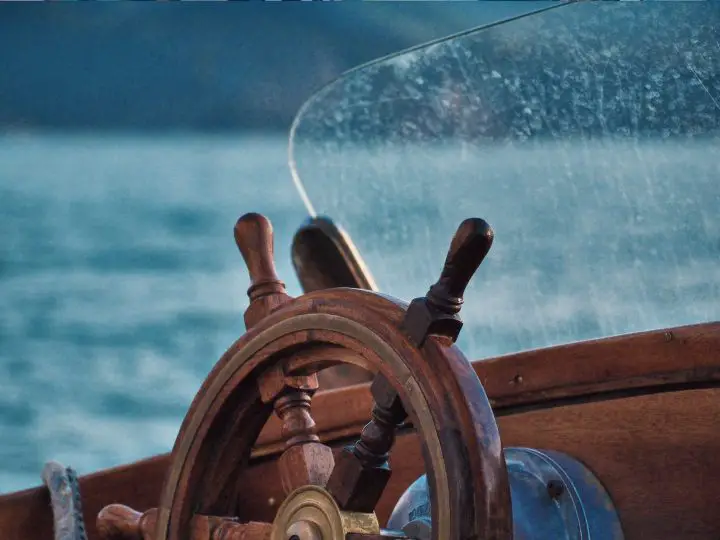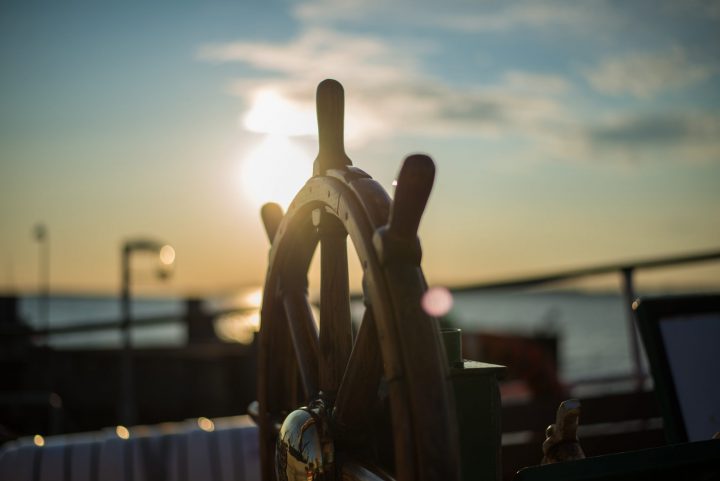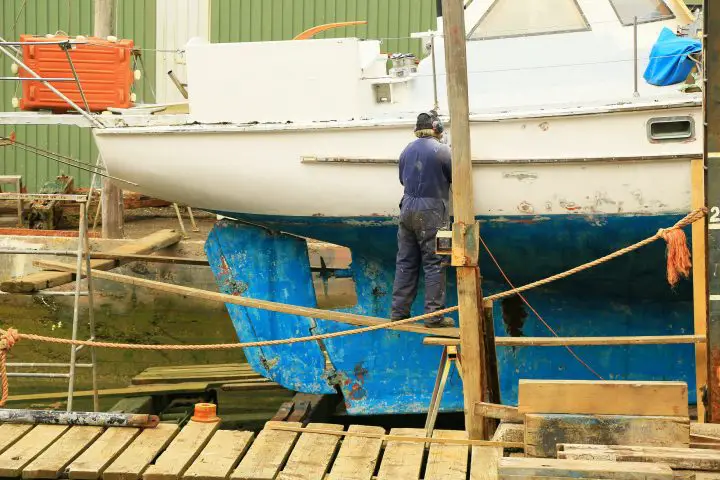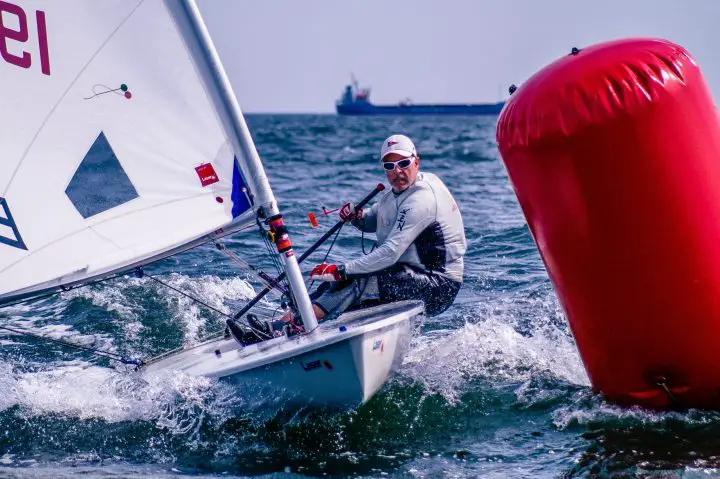There’s a ton of jargon to learn when you’re new to boating. Simple things – like what you call the steering wheel on a boat – turn out to be not so simple at all!
A ship’s steering wheel can be referred to as a wheel, ship steering wheel, ship’s wheel, boat’s wheel, control wheel, rudder, helm, or tiller.
Some would have you believe that getting the right name for things is a big deal and that you’ll look like a fool if you go around calling the steering wheel a steering wheel. But in truth, everyone started somewhere. It’s all a learning process, and most people are out on the water to have fun.
Table of Contents
- What Is a Boat Steering Wheel Called?
- What Is the Steering Wheel on a Pirate Ship Called?
- What Do Modern Ship’s Wheels Look Like?
- How Does the Rudder and Wheel of a Ship Work?
- Types of Boat Helms
- What Is a Boat Steering Wheel Called?
- FAQs (Frequently Asked Questions)

What Is a Boat Steering Wheel Called?
So, without further ado, exactly what is the steering wheel of a boat or ship called? Drum roll, please—it’s called the ship’s wheel!
But alas, the answer is more complicated than that, dear reader. While the ship wheel name applies to the actual wheel, another word pops up in the same general area–the helm. So what the heck is the helm, then?
The helm of a ship is the wheel’s location, where the helmsperson sits or stands to steer the boat. The helm is a position or location, and the wheel is the actual thing that does the turning of the ship. The helm station will include other controls, like the compass, autopilot control panel, and maybe the throttle or engine controls.
In automotive terms, the ship’s wheel is analogous to the steering wheel, and the helm is like the driver’s seat. So on a boat or ship, you might hear the helmsperson say, “take the helm,” or possibly, “take the wheel.” Either work; they both mean “drive the boat.”
Other terms you might hear the ship wheel called include:
- Wheel
- Ship steering wheel
- Ships wheel
- Boat’s wheel
- Control wheel
- Rudder
- Helm
- Tiller
What Does the Ship’s Wheel Look Like?
The ship’s wheel name applies to a specific part of the boat called the helm. Helms and ship’s wheels look different depending on what type of ship you’re on.
Where Is The Ship Steering Wheel Located?
It is typically located on the bridge or wheelhouse of a ship. The bridge is the command center for the vessel, where the captain and navigation officers control the ship’s course and speed. The specific location of the steering wheel within the bridge can vary depending on the ship’s design and layout, but it’s usually positioned in a central or forward part of the bridge to provide the helmsman with a clear view of the sea ahead and easy access to navigational instruments and controls.
On modern ships, the traditional large steering wheel may be replaced with smaller wheels or joysticks integrated into a comprehensive navigation system, reflecting advances in maritime technology.
What Is the Steering Wheel on a Pirate Ship Called?
Avast ye landlubbers and sit back while I account a tale from the high seas. You might wonder, what is the wooden, old-fashioned steering wheel on a pirate’s ship called?
It’s still referred to as the ship’s wheel or the helm. On old wooden ships, the wheels were made of wood spokes connected with wood rings on the outer rim.
Large ships often had a huge wheel that cranked rope around a winch. As you turned the wheel one way, it tightened the rope around the winch, which pulled on the rudder. This provided a mechanical advantage so the crew could move such a huge rudder without too much trouble.

What Do Modern Ship’s Wheels Look Like?
Of course, technology has evolved a lot today. For example, the wheels on modern cargo or cruise ships are much smaller. The helm station they are mounted to is also usually smaller, full of digital gauges and controls.
In fact, some ships have forgone the wheel altogether and simply have a joystick or small tiller-style lever control.
This is possible because modern ships use hydraulic controls. As a result, the helmsperson can move an enormous rudder with little trouble and a little wheel.
How Does the Rudder and Wheel of a Ship Work?
All ship’s wheels are used to turn the rudder. The rudder on a sailboat or ship is a vertical control surface located under the water on the back of the boat.
When the rudder is deflected in one direction, it will move the bow of the boat in the same direction. So if the rudder deflects to the left, the bow will turn left so long as the vessel has some forward speed. Rudders don’t do anything if the vessel is stopped.
Using the wheel on a ship is intuitive. For example, if you move the wheel to the left, the boat’s bow will turn left (when you are going forward).
On some boats, the engine moves instead of the rudder. Outboard motors, for example, move the entire engine and propeller when the wheel is turned. This allows them to be even more maneuverable than an inboard boat, especially when operating as low speed.
Big ships may also have pod drives that can be moved to improve their handling around docks and piers. These allow the ship to be much more maneuverable. If it’s equipped, the controls for the pod drives will also be located at the helm.
Some boats also have thrusters. Thrusters are propellers that are mounted sideways on the bow or stern. Activating one will move the boat to the side, a great help when docking. Thruster controls are usually joysticks mounted at the helm station. The helmsperson uses the thrusters in combination with the wheel to make tight turns.

Types of Boat Helms
So, we’ve talked about wheels and how they control the boat. But wheels are just one type of steering device to do the job. Here’s a look at some other ways you can control a boat or ship.
Steering Wheel on a Ship
On modern ships, the wheel is usually an underwhelming item on the bridge. So many of the systems on board are automated that computer controls and autopilot inputs are just as prominent. As a result, the wheel is usually small and is rarely used in general. In other words, most big ships have power steering!
On sailboats, the most prominent manufacturer of steering systems is Edson Marine. Edson makes all sorts of boat steering wheels, plus many steering gear system components like steering chains. If you flip through the Edson catalog, you will see several styles of steering wheels for boats called destroyer wheels or traditional yacht wheels.
Destroyer wheels are oversized wheels made of stainless steel and are simple, large wheels with several spokes. Edson also makes wheels out of carbon fiber for racing or performance boats.
The standard steering mechanics on a sailboat works with a system of pullies and cables. Rotating the wheel to one side tightens one cable, which pulls a horn attached to the top of the rudder.
Some boats have rack and pinion steering, much like a car. Outboard boats use a mechanical cable or hydraulics to steer the entire motor on its mount instead of a rudder.
Large ships use hydraulic systems to turn the rudder. Such huge rudders, plus the force of the water passing over it. With a hydraulic system, the wheel turns easily, and a giant pump forces the rudder to move one way or another.
What Is a Ship’s Wheel Called, and Do You Steer a Ship?
Here’s a great inside look at the helm of a big cargo ship and exactly what goes on inside the bridge. They even include a tour of the mechanical spaces and show the hydraulic pumps that do all the work!
Tiller on a Boat
Of course, there are boats out there that have no wheels. Instead, they use what is called a tiller.
A tiller is basically just a lever arm attached to the top of the rudder. You stand (or sit) to one side of the tiller, and you pull or push it side to side. Doing so turns the rudder, which turns the boat.
Tillers are a bit confusing to drive the first time you try. Since the tiller is attached in front of the rudder, moving the tiller to starboard moves the rudder (and the boat) to port. So you move the tiller in the opposite direction of the way you want to go.
But once you get the hang of it, tillers are simplicity itself. There are no pullies or cables to fail. They have no moving parts and are easy to use.
A vast majority of boats that have rudders have an emergency tiller on board. These are pipes that connect through the deck and onto the rudder shaft. That way, in case of a cable or wheel steering failure, you can install the tiller and restore control of the vessel.
You might think that a tiller could not have a sailboat autopilot system, but there are actually several ways to attach an autopilot system to a tiller. Several companies sell “tiller pilots,” which connect to the tiller right in the cockpit.
Tillers are most common on very small boats. If a boat is under 20 feet long, chances are it has a tiller. Some bigger sailboats, some as much as 40 feet long, have tillers, too. A tiller on a bigger boat is possible, but the lever arm would likely be so long that a wheel steering system would take up less space.
In addition to small sailboats, many skiffs and dinghies have outboards with tiller steering. This saves a lot of space in a small boat, so you don’t have to install a proper helm station with remote control. An outboard tiller also includes a throttle grip and gear shifter so that the helmsperson can control everything with one hand.
Steering Wheel Vs. Tiller
| Steering Wheel | Tiller | |
|---|---|---|
| Suitability | Better for larger boats | Ideal for small boats, dinghies, and sailboats |
| Control and Handling | Provides finer control and stability, especially in choppy waters | Offers direct control and a strong connection to the boat’s response |
| Comfort | More comfortable for long journeys, reduces physical strain | Can be physically demanding, especially in rough conditions |
| Space and Complexity | More complex, requires more space | Simple, takes up less space |
| Maintenance | May require more maintenance due to complex systems | Generally simpler and less expensive to maintain |
| Physical Effort | Steering mechanism absorbs much of the force, reducing effort | Requires more physical effort to maintain course |
| Cost | Potentially higher due to complexity | Less expensive due to simplicity |

What Is a Boat Steering Wheel Called?
Wheel, helm, tiller, or round thing. Don’t let the jargon slow you down when learning to boat. The point of being on the water is to have fun and learn some new skills. Remember, graphics of a ship steering wheel symbolize charting your own course and taking control. So whether you call the steering wheel of a ship a wheel or the helm, grab it and head off into the sunset. And, since it’s so important, why not dress up the steering wheel a bit?
FAQs (Frequently Asked Questions)
What is the steering wheel of ship called?
The steering wheel is usually referred to as a ship’s wheel. It is located at the helm, a position on the bridge of a ship from which it is controlled. The helm station will have controls for the throttle, autopilots, and the ship’s wheel.
What is an old boat steering wheel called?
Those old ship’s wheels, made of wood and found in antique shops everywhere, are called ship’s wheels or sometimes helms. They are made from wood. Some traditional yachts still use them, and they have teak spokes and bronze or stainless hardware.
What is the name for the steering wheel of a ship?
The steering wheel of a ship is called the helm or ship’s wheel.
Who handles the ship’s steering wheel when needed?
The handling of the ship’s steering wheel, or helm, is a responsibility entrusted to a member of the ship’s crew known as the helmsman. The helmsman operates under the direction of the ship’s captain or the officer of the watch, who are responsible for navigating the vessel. The primary duty of the helmsman is to steer the ship according to the orders given by these commanding officers, ensuring the vessel follows the intended course.
The captain has the ultimate authority and responsibility for the ship, including its navigation and safe operation.
Is the steering wheel on a boat the helm?
Yes, the steering wheel on a boat is often referred to as the helm.
